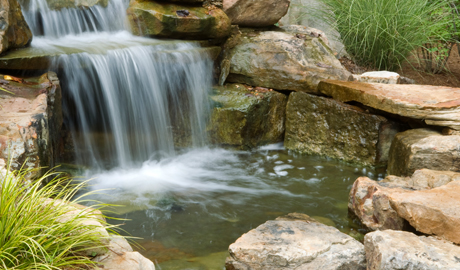Pond Basics

Choose Your Location
- Where in the landscape do you want you pond? Tucked away or as a focal point?
- Do you have full sun, partial sun, or full shade? At least 6 hours of sunlight is needed for most water lillies.
- Is there runoff where you wish to place the pond? Runoff can introduce chemicals, fertilizers and pesticides to your pond. This can be deadly.
- Is it possible to dig down at least 18” – 24”? Fish need this depth for optimum health.
- Do you have access to electricity at your proposed site?
- Check with you local township for the depth you can make your pond before you need a fence. This can vary greatly by township.
The Basics Needed To Set Up Your Pond:
Pond Liner
Either rigid or flexible. Check when buying liners for warranties. Most come with a 20 year warranty, however cheaper material usually does not come with a warranty.
Filters
Mechanical, Biological, or Natural.
- Mechanical trap particles in material for cleaning. They also usually contain zeolite and/or carbon, to neutralize ammonia.
- Biological filters use beneficial bacteria to feed on nutrients in the pond. The bacteria, breaks down ammonia, and nitrogen.
- Natural filters use plants and beneficial bacteria to take ammonia and nitrogen out of the water.
The mechanical and biological filters can be above ground, partially buried in the ground, or submerged. These filters can also be used in combination with one another.
Pumps
Pumps are used to run you filter. They can also be used to run a waterfall, fountain or Spitter. Pumps running a biological filter should pump at half of the volume of the pond in an hour. Pumps running a mechanical filter should move the volume of the pond in an hour. (For example a biological filter for a 500 gallon pond should pump the water 250 gallons per hour.) Pumps purchased for a waterfall need 50-100 gallons per hour per inch of waterfall width. (For example a 10” wide waterfall needs at least 500 gallons per hour.) Check pump packages for the gallons per hour at different pumping heights.
Pond Flora & Fauna:
Plants come in four types: Underwater, Floating, Surface and Marginal.
- Underwater plants are primarily oxygenators.
- Floating plants and surface plants help to achieve the 40-60% of needed surface coverage.
- Marginal plants usually grow on a “plant shelf: The plant shelf in your pond should be about 12” in depth. Marginal plants come in a wide variety and help to create an atmosphere, as well as working at taking nutrients out of the pond.
Many people stock their pond with fish, tadpoles and snails. Fish should be stocked at no more that 1” of fish for every 10 gallons of pond water. If you have more fish, you will either need a very good filtration system or you will have health and water quality problems. Remember, fish grow and they do have baby fish.
Helpful Formulas:
The formula for calculating gallons for a rectangular pond is:
Length x width x average depth x 7.5 = gallons
The formula for calculating gallons for a circular pond is:
3.14 x radius 2x depth = gallons
The formula for computing the appropriate liner size is:
Width: pond width = 2x the pond depth + 2’ for edging.
Length: pond length = 2x the pond depth + 2’ for edging.
Still have questions? Just ask us in store or online! We want you and your pond to be successful.
